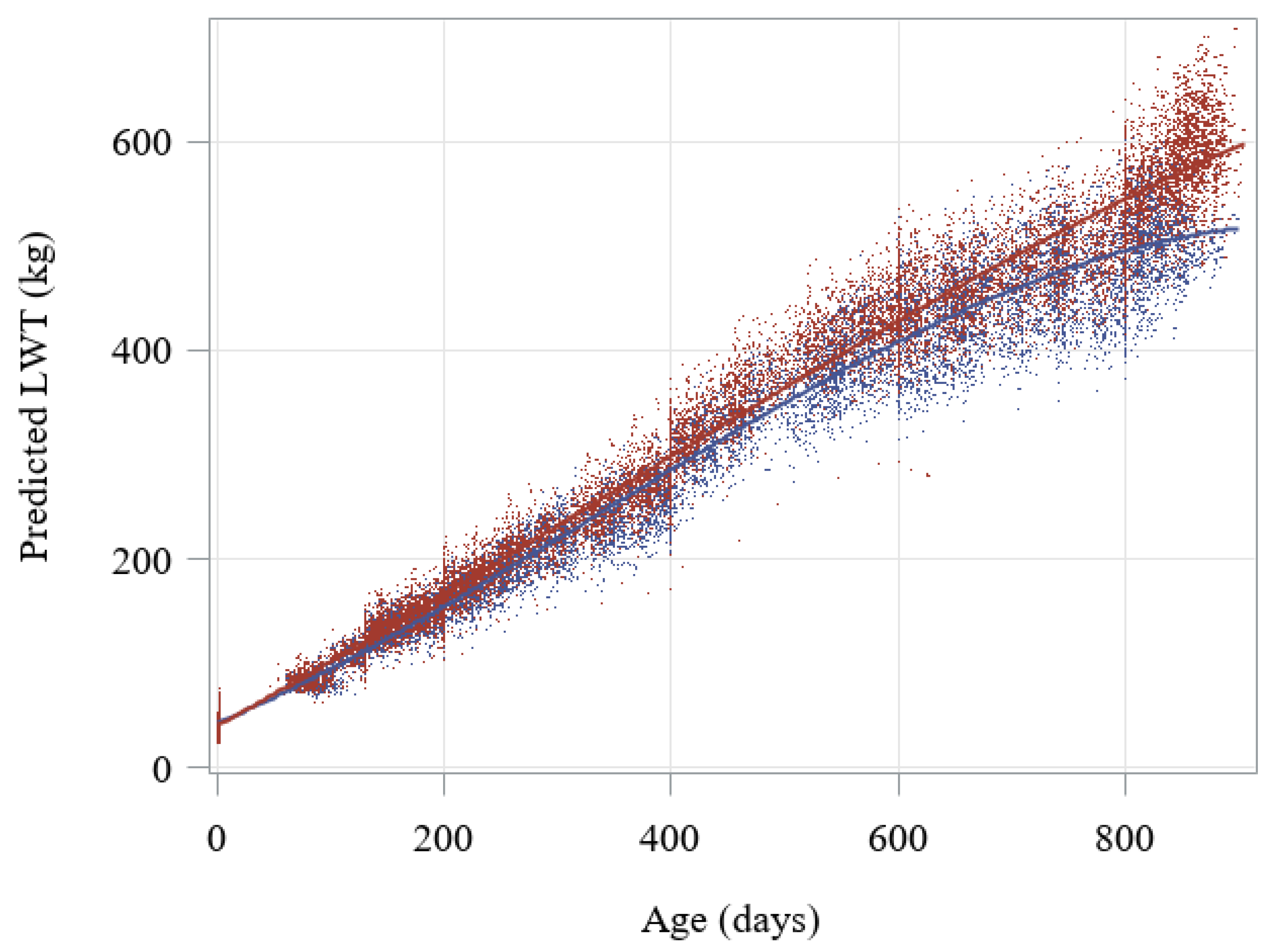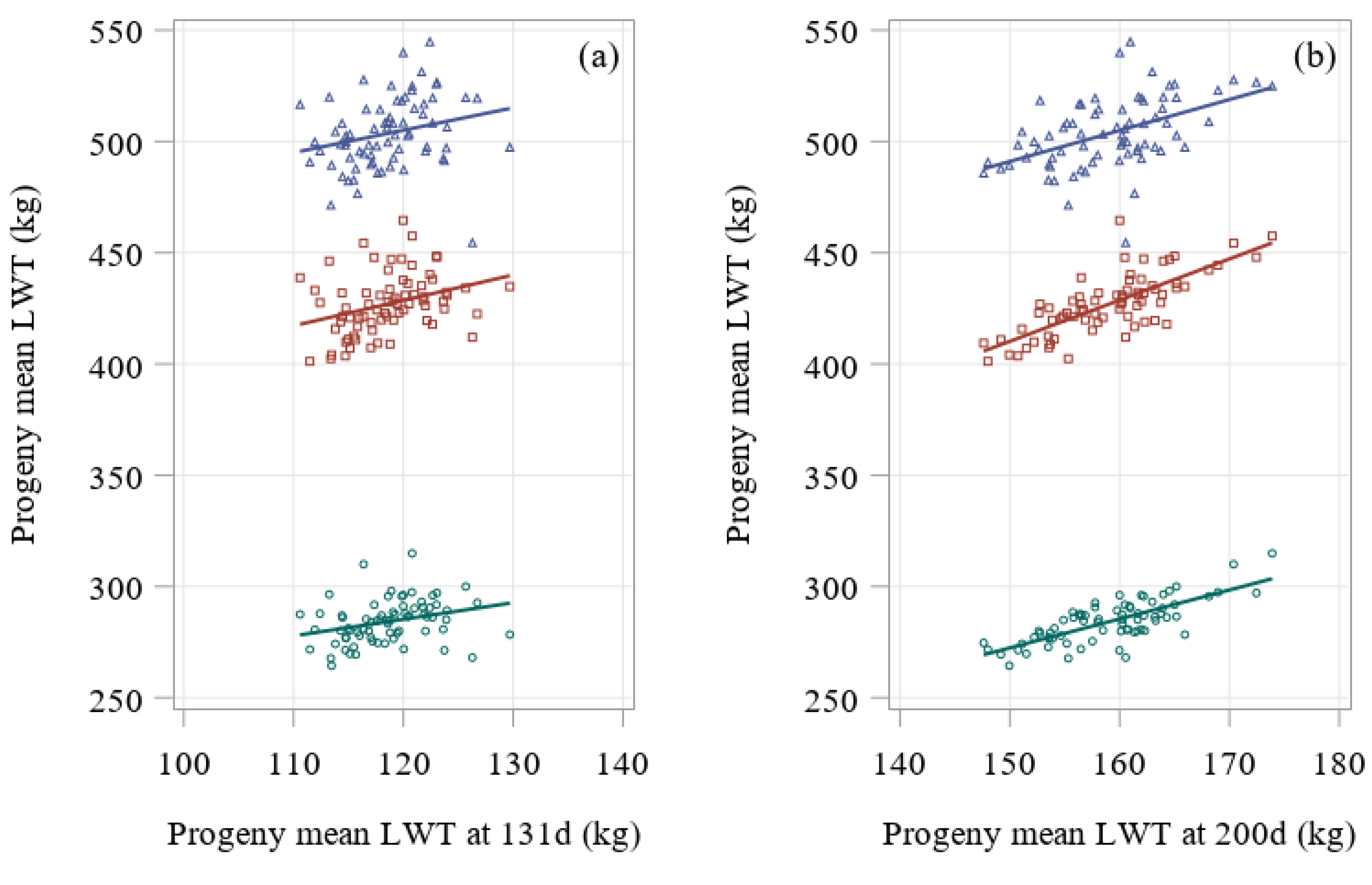Sire Effects on Post-Weaning Growth of Beef-Cross-Dairy Cattle: A Case Study in New Zealand
Abstract
Simple Summary
Abstract
1. Introduction
2. Materials and Methods
2.1. Animals
2.1.1. Beef Sire Selection
2.1.2. Calving and Rearing at the Dairy Farm, before Current Experiment
2.2. Feed Management at the Beef Farm
2.3. Live Weight Measurements
2.4. Statistical Analysis
2.4.1. Data Cleaning
2.4.2. Predicting Live Weights at Specific Age
2.4.3. Contemporary Groups
2.4.4. Statistical Models
3. Results
3.1. Growth Curves of Beef-Cross-Dairy Progeny
3.2. Live Weights by Sire
3.3. Comparison of Progeny Means for Live Weight at Different Ages
4. Discussion
5. Conclusions
Author Contributions
Funding
Acknowledgments
Conflicts of Interest
References
- Ministry for Primary Industries. Livestock Slaughter Statistics. Available online: http://www.mpi.govt.nz/news-and-resources/open-data-and-forecasting/agriculture (accessed on 5 December 2019).
- van Selm, B.; de Boer, I.J.M.; Ledgard, S.F.; van Middelaar, C.E. Reducing greenhouse gas emissions of New Zealand beef through better integration of dairy and beef production. Agric. Syst. 2021, 186, 102936. [Google Scholar] [CrossRef]
- Beef+Lamb New Zealand Economic Service & Insights (Wellington, New Zealand). Export Cattle Slaughter by Beef and Dairy Origin. Personal communication, 2020. [Google Scholar]
- Beef+Lamb New Zealand. Beef+Lamb New Zealand. Beef industry overview. In Guide to New Zealand Cattle Farming; Geenty, K., Morris, S., Eds.; Beef+Lamb New Zealand: Wellington, New Zealand, 2017; pp. 2–12. [Google Scholar]
- Berry, D.P.; Crowley, J.J. Cell Biology Symposium: Genetics of feed efficiency in dairy and beef cattle. J. Anim. Sci. 2013, 91, 1594–1613. [Google Scholar] [CrossRef] [PubMed]
- Beef+Lamb New Zealand. Feeding and efficiency. In Guide to New Zealand Cattle Farming; Geenty, K., Morris, S., Eds.; Beef+Lamb New Zealand: Wellington, New Zealand, 2017; pp. 37–47. [Google Scholar]
- Archer, J.A.; Herd, R.M.; Arthur, P.F.; Parnell, P.F. Correlated responses in rate of maturation and mature size of cows and steers to divergent selection for yearling growth rate in Angus cattle. Livest. Prod. Sci. 1998, 54, 183–192. [Google Scholar] [CrossRef]
- McIntyre, B.L.; Tudor, G.D.; Read, D.; Smart, W.; Della Bosca, T.J.; Speijers, E.J.; Orchard, B. Effects of growth path, sire type, calving time and sex on growth and carcass characteristics of beef cattle in the agricultural area of Western Australia. Anim. Prod. Sci. 2009, 49, 504–514. [Google Scholar] [CrossRef]
- Beef+Lamb New Zealand. Genetic Improvement. In Guide to New Zealand Cattle Farming; Geenty, K., Morris, S., Eds.; Beef+Lamb New Zealand: Wellington, New Zealand, 2017; pp. 62–81. [Google Scholar]
- Cunningham, B.E.; Magee, W.T.; Ritchie, H.D. Effects of using sires selected for yearling weight and crossbreeding with beef and dairy breeds: Birth and weaning traits. J. Anim. Sci. 1987, 64, 1591–1600. [Google Scholar] [CrossRef] [PubMed]
- Morris, S.T.; Parker, W.J.; Purchas, R.W.; McCutcheon, S.N. Dairy crossbreeding alternatives to improve New Zealand beef production. In Proceedings of the New Zealand Grassland Association, Gore, New Zealand, 2–5 November 1992; pp. 19–22. [Google Scholar]
- Dal Zotto, R.; Penasa, M.; De Marchi, M.; Cassandro, M.; López-Villalobos, N.; Bittante, G. Use of crossbreeding with beef bulls in dairy herds: Effect on age, body weight, price, and market value of calves sold at livestock auctions. J. Anim. Sci. 2009, 87, 3053–3059. [Google Scholar] [CrossRef] [PubMed]
- Berry, D.P.; Amer, P.R.; Evans, R.D.; Byrne, T.; Cromie, A.R.; Hely, F. A breeding index to rank beef bulls for use on dairy females to maximize profit. J. Dairy Sci. 2019, 102, 10056–10072. [Google Scholar] [CrossRef] [PubMed]
- DairyNZ. NZAEL: New Zealand Animal Evaluation Limited. Available online: https://www.dairynz.co.nz/animal/animal-evaluation/ (accessed on 19 October 2020).
- Beef+Lamb New Zealand Economic Service. Compendium of New Zealand Farm Facts 2018. In Farm Facts, 41st ed.; Beef+Lamb New Zealand: Wellington, New Zealand, 2018; p. 32. [Google Scholar]
- Coleman, L.W. The Use of High Genetic Merit Angus and Hereford Bulls in a New Zealand Dairy Herd. Ph.D. Thesis, Massey University, Palmerston North, New Zealand, 2020. [Google Scholar]
- Agricultural Business Research Institute. Breedplan: International Beef Recording Scheme. Available online: https://breedplan.une.edu.au/ (accessed on 1 April 2020).
- Puha, M.R.; King, W.M.; Burggraaf, V.T.; Roberts, A.H.C. Pasture production gains from strategic winter nitrogen applications on a North Island sheep and beef hill country farm. In Proceedings of the New Zealand Grassland Association, Blenheim, New Zealand, 14–16 October 2008; pp. 117–121. [Google Scholar]
- Morris, S.; Hickson, R. An overview of current and potential hill country livestock systems. In Proceedings of the Hill Country Symposium, Rotorua, New Zealand, 12–13 April 2016; pp. 309–316. [Google Scholar]
- Muir, P.D.; Nieuwenhuis, G.; Smith, N.B.; Ormond, A.W.A. A comparison of rearing systems for dairy beef calves. In Proceedings of the New Zealand Grassland Association, Invercargill, New Zealand, 31 October–2 November 2000; pp. 9–12. [Google Scholar]
- Beef+Lamb New Zealand Genetics. Sire Report: Cohort 2; Beef+Lamb New Zealand: Dunedin, New Zealand, 2019; p. 16. [Google Scholar]
- Beef+Lamb New Zealand. Post weaning systems. In Guide to New Zealand Cattle Farming; Geenty, K., Morris, S., Eds.; Beef+Lamb New Zealand: Wellington, New Zealand, 2017; pp. 23–36. [Google Scholar]
- Pettigrew, E.J.; Morris, S.T.; Back, P.J.; Kenyon, P.R.; Berry, J.; Donald, A.J.; Lane, A.L.; Hickson, R.E. Growth of weaned Friesian bull calves on a herb sward or with concentrate supplementation during late summer and early autumn. N. Z. J. Agric. Res. 2017, 60, 70–79. [Google Scholar] [CrossRef]
- Afolayan, R.A.; Pitchford, W.S.; Deland, M.P.; McKiernan, W.A. Breed variation and genetic parameters for growth and body development in diverse beef cattle genotypes. Animal 2007, 1, 13–20. [Google Scholar] [CrossRef] [PubMed]
- NSW Department of Primary Industries. Frame Scoring of Beef Cattle. Available online: http://www.dpi.nsw.gov.au/animals-and-livestock/beef-cattle/appraisal/publications/frame-scoring (accessed on 20 October 2020).
- Thonney, M.L. Genetics of Growth and Body Composition. In The Genetics of Cattle, 2nd ed.; Garrick, D.J., Ruvinsky, A., Eds.; CAB International: Wallingford, UK, 2015; pp. 523–543. ISBN 978-1-78064-221-5. [Google Scholar]
- Lawrie, R.A. Chapter 2—Factors influencing the growth and development of meat animals. In Lawrie’s Meat Science, 7th ed.; Lawrie, R.A., Ed.; Woodhead Publishing: Cambridge, UK, 2006; pp. 15–40. ISBN 978-1-84569-159-2. [Google Scholar]
- Litherland, A.J.; Woodward, S.J.R.; Stevens, D.R.; McDougal, D.B.; Boom, C.J.; Knight, T.L.; Lambert, M.G. Seasonal variations in pasture quality on New Zealand sheep and beef farms. In Proceedings of the New Zealand Society of Animal Production, Palmerston North, New Zealand, 24–26 June 2002; pp. 138–142. [Google Scholar]
- Burke, J.L.; Waghorn, G.C.; Chaves, A.V. Improving animal performance using forage-based diets. In Proceedings of the New Zealand Society of Animal Production, Palmerston North, New Zealand, 24–26 June 2002; pp. 267–272. [Google Scholar]
- Buchanan, D.S.; Lenstra, J.A. Breeds of Cattle. In The Genetics of Cattle, 2nd ed.; Garrick, D.J., Ruvinsky, A., Eds.; CAB International: Wallingford, UK, 2015; pp. 33–66. ISBN 978-1-78064-221-5. [Google Scholar]
- Barton, R.A.; Donaldson, J.L.; Barnes, F.R.; Jones, C.F.; Clifford, H.J. Comparison of Friesian, Friesian-Jersey cross, and Jersey steers in beef production. N. Z. J. Agric. Res. 1994, 37, 51–58. [Google Scholar] [CrossRef]
- Handcock, R.C.; Lopez-Villalobos, N.; McNaughton, L.R.; Back, P.J.; Edwards, G.R.; Hickson, R.E. Live weight and growth of Holstein-Friesian, Jersey and crossbred dairy heifers in New Zealand. N. Z. J. Agric. Res. 2018, 62, 173–183. [Google Scholar] [CrossRef]
- Coleman, L.W.; Back, P.J.; Blair, H.T.; Lopez-Villalobos, N.; Hickson, R.E. Milk production and rebreeding performance of mixed-aged dairy cows mated to Angus or Hereford bulls. N. Z. J. Anim. Sci. Prod. 2019, 79, 144–148. [Google Scholar]



| Trait | Angus | Hereford | ||||
|---|---|---|---|---|---|---|
| n | EBV | EBV Range | n | EBV | EBV Range | |
| 200d weight (kg) | 37 | 39 ± 10 | (18 to 59) | 40 | 30 ± 7 | (18 to 48) |
| 400d weight (kg) | 37 | 75 ± 14 | (41 to 110) | 40 | 54 ± 13 | (31 to 79) |
| 600d weight (kg) | 37 | 96 ± 21 | (49 to 135) | 40 | 73 ± 19 | (35 to 114) |
| Age (Days) | n | Progeny Mean LWT (kg) | Sire Effect p-Value |
|---|---|---|---|
| 131 | 1101 | 118.6 ± 3.9 | 0.002 |
| 200 | 1086 | 159.1 ± 5.5 | <0.001 |
| 400 | 1069 | 284.2 ± 9.6 | <0.001 |
| 600 | 1035 | 427.0 ± 13.5 | <0.001 |
| 800 | 913 | 503.6 ± 15.9 | <0.001 |
| Progeny Mean | LWT 131 Days | LWT 200 Days | ||||||
|---|---|---|---|---|---|---|---|---|
| Intercept | Slope | p-Value | R2 | Intercept | Slope | p-Value | R2 | |
| LWT 400d (kg) | 236 ± 33 | 0.4 ± 0.3 | 0.149 | 0.03 | 82 ± 23 | 1.3 ± 0.2 | <0.001 | 0.51 |
| LWT 600d (kg) | 333 ± 44 | 0.8 ± 0.4 | 0.035 | 0.06 | 144 ± 30 | 1.8 ± 0.2 | <0.001 | 0.55 |
| LWT 800d (kg) | 461 ± 57 | 0.4 ± 0.5 | 0.466 | 0.01 | 296 ± 53 | 1.3 ± 0.3 | <0.001 | 0.18 |
Publisher’s Note: MDPI stays neutral with regard to jurisdictional claims in published maps and institutional affiliations. |
© 2020 by the authors. Licensee MDPI, Basel, Switzerland. This article is an open access article distributed under the terms and conditions of the Creative Commons Attribution (CC BY) license (http://creativecommons.org/licenses/by/4.0/).
Share and Cite
Martín, N.; Schreurs, N.; Morris, S.; López-Villalobos, N.; McDade, J.; Hickson, R. Sire Effects on Post-Weaning Growth of Beef-Cross-Dairy Cattle: A Case Study in New Zealand. Animals 2020, 10, 2313. https://doi.org/10.3390/ani10122313
Martín N, Schreurs N, Morris S, López-Villalobos N, McDade J, Hickson R. Sire Effects on Post-Weaning Growth of Beef-Cross-Dairy Cattle: A Case Study in New Zealand. Animals. 2020; 10(12):2313. https://doi.org/10.3390/ani10122313
Chicago/Turabian StyleMartín, Natalia, Nicola Schreurs, Stephen Morris, Nicolás López-Villalobos, Julie McDade, and Rebecca Hickson. 2020. "Sire Effects on Post-Weaning Growth of Beef-Cross-Dairy Cattle: A Case Study in New Zealand" Animals 10, no. 12: 2313. https://doi.org/10.3390/ani10122313
APA StyleMartín, N., Schreurs, N., Morris, S., López-Villalobos, N., McDade, J., & Hickson, R. (2020). Sire Effects on Post-Weaning Growth of Beef-Cross-Dairy Cattle: A Case Study in New Zealand. Animals, 10(12), 2313. https://doi.org/10.3390/ani10122313






